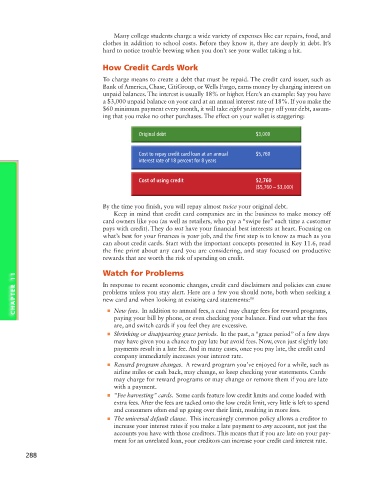Page 326 - Keys To Community College Success
P. 326
Many college students charge a wide variety of expenses like car repairs, food, and
clothes in addition to school costs. Before they know it, they are deeply in debt. It’s
hard to notice trouble brewing when you don’t see your wallet taking a hit.
How Credit Cards Work
To charge means to create a debt that must be repaid. The credit card issuer, such as
Bank of America, Chase, CitiGroup, or Wells Fargo, earns money by charging interest on
unpaid balances. The interest is usually 18% or higher. Here’s an example: Say you have
a $3,000 unpaid balance on your card at an annual interest rate of 18%. If you make the
$60 minimum payment every month, it will take eight years to pay off your debt, assum-
ing that you make no other purchases. The effect on your wallet is staggering:
Original debt $3,000
Cost to repay credit card loan at an annual $5,760
interest rate of 18 percent for 8 years
Cost of using credit $2,760
($5,760 – $3,000)
By the time you finish, you will repay almost twice your original debt.
Keep in mind that credit card companies are in the business to make money off
card owners like you (as well as retailers, who pay a “swipe fee” each time a customer
pays with credit). They do not have your financial best interests at heart. Focusing on
what’s best for your finances is your job, and the first step is to know as much as you
can about credit cards. Start with the important concepts presented in Key 11.6, read
the fine print about any card you are considering, and stay focused on productive
rewards that are worth the risk of spending on credit.
11 Watch for Problems
In response to recent economic changes, credit card disclaimers and policies can cause
CHAPTER problems unless you stay alert. Here are a few you should note, both when seeking a
new card and when looking at existing card statements:
16
■ New fees. In addition to annual fees, a card may charge fees for reward programs,
paying your bill by phone, or even checking your balance. Find out what the fees
are, and switch cards if you feel they are excessive.
■ Shrinking or disappearing grace periods. In the past, a “grace period” of a few days
may have given you a chance to pay late but avoid fees. Now, even just slightly late
payments result in a late fee. And in many cases, once you pay late, the credit card
company immediately increases your interest rate.
■ Reward program changes. A reward program you’ve enjoyed for a while, such as
airline miles or cash back, may change, so keep checking your statements. Cards
may charge for reward programs or may change or remove them if you are late
with a payment.
■ “Fee harvesting” cards. Some cards feature low credit limits and come loaded with
extra fees. After the fees are tacked onto the low credit limit, very little is left to spend
and consumers often end up going over their limit, resulting in more fees.
■ The universal default clause. This increasingly common policy allows a creditor to
increase your interest rates if you make a late payment to any account, not just the
accounts you have with those creditors. This means that if you are late on your pay-
ment for an unrelated loan, your creditors can increase your credit card interest rate.
288

